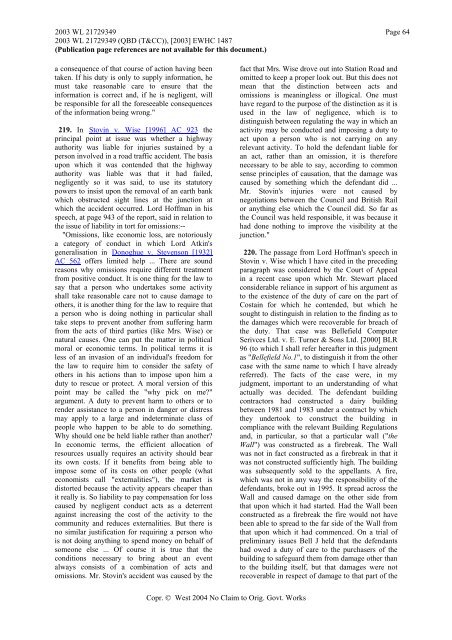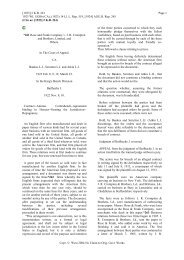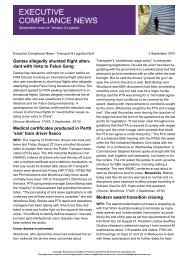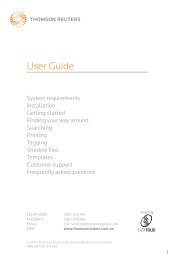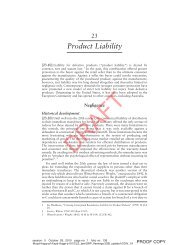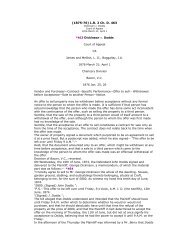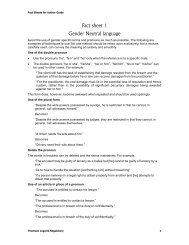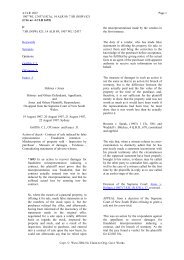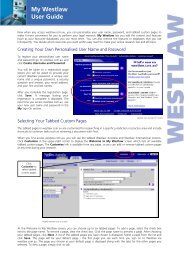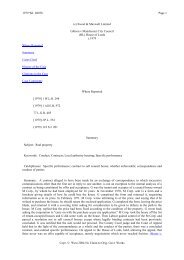Tesco v Constain - Thomson Reuters
Tesco v Constain - Thomson Reuters
Tesco v Constain - Thomson Reuters
You also want an ePaper? Increase the reach of your titles
YUMPU automatically turns print PDFs into web optimized ePapers that Google loves.
2003 WL 21729349 Page 642003 WL 21729349 (QBD (T&CC)), [2003] EWHC 1487(Publication page references are not available for this document.)a consequence of that course of action having beentaken. If his duty is only to supply information, hemust take reasonable care to ensure that theinformation is correct and, if he is negligent, willbe responsible for all the foreseeable consequencesof the information being wrong."219. In HStovin v. Wise [1996] AC 923 theprincipal point at issue was whether a highwayauthority was liable for injuries sustained by aperson involved in a road traffic accident. The basisupon which it was contended that the highwayauthority was liable was that it had failed,negligently so it was said, to use its statutorypowers to insist upon the removal of an earth bankwhich obstructed sight lines at the junction atwhich the accident occurred. Lord Hoffman in hisspeech, at page 943 of the report, said in relation tothe issue of liability in tort for omissions:--"Omissions, like economic loss, are notoriouslya category of conduct in which Lord Atkin'sgeneralisation in HDonoghue v. Stevenson [1932]AC 562 offers limited help ... There are soundreasons why omissions require different treatmentfrom positive conduct. It is one thing for the law tosay that a person who undertakes some activityshall take reasonable care not to cause damage toothers, it is another thing for the law to require thata person who is doing nothing in particular shalltake steps to prevent another from suffering harmfrom the acts of third parties (like Mrs. Wise) ornatural causes. One can put the matter in politicalmoral or economic terms. In political terms it isless of an invasion of an individual's freedom forthe law to require him to consider the safety ofothers in his actions than to impose upon him aduty to rescue or protect. A moral version of thispoint may be called the "why pick on me?"argument. A duty to prevent harm to others or torender assistance to a person in danger or distressmay apply to a large and indeterminate class ofpeople who happen to be able to do something.Why should one be held liable rather than another?In economic terms, the efficient allocation ofresources usually requires an activity should bearits own costs. If it benefits from being able toimpose some of its costs on other people (whateconomists call "externalities"), the market isdistorted because the activity appears cheaper thanit really is. So liability to pay compensation for losscaused by negligent conduct acts as a deterrentagainst increasing the cost of the activity to thecommunity and reduces externalities. But there isno similar justification for requiring a person whois not doing anything to spend money on behalf ofsomeone else ... Of course it is true that theconditions necessary to bring about an eventalways consists of a combination of acts andomissions. Mr. Stovin's accident was caused by thefact that Mrs. Wise drove out into Station Road andomitted to keep a proper look out. But this does notmean that the distinction between acts andomissions is meaningless or illogical. One musthave regard to the purpose of the distinction as it isused in the law of negligence, which is todistinguish between regulating the way in which anactivity may be conducted and imposing a duty toact upon a person who is not carrying on anyrelevant activity. To hold the defendant liable foran act, rather than an omission, it is thereforenecessary to be able to say, according to commonsense principles of causation, that the damage wascaused by something which the defendant did ...Mr. Stovin's injuries were not caused bynegotiations between the Council and British Railor anything else which the Council did. So far asthe Council was held responsible, it was because ithad done nothing to improve the visibility at thejunction."220. The passage from Lord Hoffman's speech inStovin v. Wise which I have cited in the precedingparagraph was considered by the Court of Appealin a recent case upon which Mr. Stewart placedconsiderable reliance in support of his argument asto the existence of the duty of care on the part ofCostain for which he contended, but which hesought to distinguish in relation to the finding as tothe damages which were recoverable for breach ofthe duty. That case was Bellefield ComputerSerivces Ltd. v. E. Turner & Sons Ltd. [2000] BLR96 (to which I shall refer hereafter in this judgmentas "Bellefield No.1", to distinguish it from the othercase with the same name to which I have alreadyreferred). The facts of the case were, in myjudgment, important to an understanding of whatactually was decided. The defendant buildingcontractors had constructed a dairy buildingbetween 1981 and 1983 under a contract by whichthey undertook to construct the building incompliance with the relevant Building Regulationsand, in particular, so that a particular wall ("theWall") was constructed as a firebreak. The Wallwas not in fact constructed as a firebreak in that itwas not constructed sufficiently high. The buildingwas subsequently sold to the appellants. A fire,which was not in any way the responsibility of thedefendants, broke out in 1995. It spread across theWall and caused damage on the other side fromthat upon which it had started. Had the Wall beenconstructed as a firebreak the fire would not havebeen able to spread to the far side of the Wall fromthat upon which it had commenced. On a trial ofpreliminary issues Bell J held that the defendantshad owed a duty of care to the purchasers of thebuilding to safeguard them from damage other thanto the building itself, but that damages were notrecoverable in respect of damage to that part of theCopr. © West 2004 No Claim to Orig. Govt. Works


